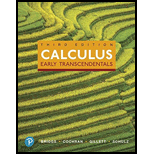
(a)
Whether the statement “The level curves of
(a)
Answer to Problem 1RE
The statement is true.
Explanation of Solution
The given function is,
Let
Take log on both sides.
Here,
Therefore, the statement is true.
(b)
Whether the equation
(b)
Answer to Problem 1RE
The statement is false.
Explanation of Solution
Given:
The equation is
Calculation:
The given equation is
When
The functions are
Therefore, the statement is false.
(c)
Whether the function f satisfies the derivative
(c)
Answer to Problem 1RE
The statement is false.
Explanation of Solution
Let the function f has a continuous partial derivatives of all orders.
Then prove that
For example, assume
Obtain the value of
Take partial derivative of the function f with respect to x and obtain
Thus,
Take partial derivative of the equation (1) with respect to x and obtain
Hence,
Again, take partial derivative for the equation (2) with respect to y and obtain
Therefore,
Obtain the value of
Take partial derivative of the function f with respect to y and obtain
Thus,
Take partial derivative of the equation (1) with respect to y and obtain
Hence,
Again, take partial derivative for the equation (2) with respect to x and obtain
Therefore,
From above, it is concluded that
Thus,
Therefore, the statement is false.
(d)
Whether the gradient
(d)
Answer to Problem 1RE
The statement is false.
Explanation of Solution
Given:
The surface is
Theorem used:
The Gradient and Level Curves:
“Given a function f differentiable at
Description:
The given surface is
By above theorem, it can be concluded that the line tangent to the level curve of f at
Thus, it does not satisfy the given statement. Because, it is given that the gradient
Here,
Therefore, the statement is false.
Want to see more full solutions like this?
Chapter 15 Solutions
Calculus: Early Transcendentals, Books a la Carte, and MyLab Math with Pearson eText -- Title-Specific Access Card Package (3rd Edition)
Additional Math Textbook Solutions
College Algebra (7th Edition)
Pre-Algebra Student Edition
Calculus: Early Transcendentals (2nd Edition)
Introductory Statistics
University Calculus: Early Transcendentals (4th Edition)
- Find the values of p for which the series is convergent. P-?- ✓ 00 Σ nº (1 + n10)p n = 1 Need Help? Read It Watch It SUBMIT ANSWER [-/4 Points] DETAILS MY NOTES SESSCALCET2 8.3.513.XP. Consider the following series. 00 Σ n = 1 1 6 n° (a) Use the sum of the first 10 terms to estimate the sum of the given series. (Round the answer to six decimal places.) $10 = (b) Improve this estimate using the following inequalities with n = 10. (Round your answers to six decimal places.) Sn + + Los f(x) dx ≤s ≤ S₁ + Jn + 1 + Lo f(x) dx ≤s ≤ (c) Using the Remainder Estimate for the Integral Test, find a value of n that will ensure that the error in the approximation s≈s is less than 0.0000001. On > 11 n> -18 On > 18 On > 0 On > 6 Need Help? Read It Watch Itarrow_forward√5 Find Lª³ L² y-are y- arctan (+) dy dydx. Hint: Use integration by parts. SolidUnderSurface z=y*arctan(1/x) Z1 2 y 1 1 Round your answer to 4 decimal places.arrow_forwardFor the solid lying under the surface z = √√4-² and bounded by the rectangular region R = [0,2]x[0,2] as illustrated in this graph: Double Integral Plot of integrand over Region R 1.5 Z 1- 0.5- 0 0.5 1 1.5 205115 Answer should be in exact math format. For example, some multiple of .arrow_forward
- Find 2 S² 0 0 (4x+2y)5dxdyarrow_forward(14 points) Let S = {(x, y, z) | z = e−(x²+y²), x² + y² ≤ 1}. The surface is the graph of ze(+2) sitting over the unit disk.arrow_forward6. Solve the system of differential equations using Laplace Transforms: x(t) = 3x₁ (t) + 4x2(t) x(t) = -4x₁(t) + 3x2(t) x₁(0) = 1,x2(0) = 0arrow_forward
- 3. Determine the Laplace Transform for the following functions. Show all of your work: 1-t, 0 ≤t<3 a. e(t) = t2, 3≤t<5 4, t≥ 5 b. f(t) = f(tt)e-3(-) cos 4τ drarrow_forward4. Find the inverse Laplace Transform Show all of your work: a. F(s) = = 2s-3 (s²-10s+61)(5-3) se-2s b. G(s) = (s+2)²arrow_forward1. Consider the differential equation, show all of your work: dy =(y2)(y+1) dx a. Determine the equilibrium solutions for the differential equation. b. Where is the differential equation increasing or decreasing? c. Where are the changes in concavity? d. Suppose that y(0)=0, what is the value of y as t goes to infinity?arrow_forward
- 2. Suppose a LC circuit has the following differential equation: q'+4q=6etcos 4t, q(0) = 1 a. Find the function for q(t), use any method that we have studied in the course. b. What is the transient and the steady-state of the circuit?arrow_forward5. Use variation of parameters to find the general solution to the differential equation: y" - 6y' + 9y=e3x Inxarrow_forwardLet the region R be the area enclosed by the function f(x) = ln (x) + 2 and g(x) = x. Write an integral in terms of x and also an integral in terms of y that would represent the area of the region R. If necessary, round limit values to the nearest thousandth. 5 4 3 2 1 y x 1 2 3 4arrow_forward
 Elements Of Modern AlgebraAlgebraISBN:9781285463230Author:Gilbert, Linda, JimmiePublisher:Cengage Learning,
Elements Of Modern AlgebraAlgebraISBN:9781285463230Author:Gilbert, Linda, JimmiePublisher:Cengage Learning,
